Adaptive target and jamming recognition for the pulse doppler radar fuze based on a time-frequency joint feature and an online-updated naive bayesian classi fier with minimal risk
2022-03-29JianDaiXinhongHaoZeLiPingLiXiaopengYanScienceandTechnologyonElectromechanicalDynamicControlLaboratorySchoolofMechatronicalEngineeringBeijingInstituteofTechnologyBeijing100081China
Jian Dai,Xin-hong Hao,Ze Li,Ping Li,Xiao-peng YanScience and Technology on Electromechanical Dynamic Control Laboratory,School of Mechatronical Engineering,Beijing Institute of Technology,Beijing,100081,China
Keywords:Pulse Doppler radar fuze(PDRF)Target and jamming recognition Time-frequency joint feature Online-update naive Bayesian classi fier minimal risk(ONBCMR)
ABSTRACT This paper considers the problem of target and jamming recognition for the pulse Doppler radar fuze(PDRF).To solve the problem,the matched filter outputs of the PDRF under the action of target and jamming are analyzed.Then,the frequency entropy and peak-to-peak ratio are extracted from the matched filter output of the PDRF,and the time-frequency joint feature is constructed.Based on the time-frequency joint feature,the naive Bayesian classi fier(NBC)with minimal risk is established for target and jamming recognition.To improve the adaptability of the proposed method in complex environments,an online update process that adaptively modi fies the classi fier in the duration of the work of the PDRF is proposed.The experiments show that the PDRF can maintain high recognition accuracy when the signal-to-noise ratio(SNR)decreases and the jamming-to-signal ratio(JSR)increases.Moreover,the applicable analysis shows that he ONBCMR method has low computational complexity and can fully meet the real-time requirements of PDRF.
1.Introduction
The PDRF is a kind of proximity radar with high real-time performance,it plays an important role in missile systems due to its high range resolution.However,the increasingly complex electromagnetics seriously threaten the function of the PDRF,which may lead to the failure of a missile system[1,2].[3,4]analyzed the target recognition and jamming suppression ability of the PDRF,and the results shows that the PDRF is vulnerable to jamming.
To improve the anti-jamming ability of the PDRF,pseudorandom sequences are often used in pulse compression[5-9].Reference[5]proposed the application of chaotic pseudorandom sequences in fuze transmission signals,and the research results show that the signals generated by this method have ideal target recognition and jamming suppression performance.Reference[6]proposed a phase modulation signal based on a simple pseudorandom sequence,and the results showed that the method was easy to implement and improved the anti-jamming ability of PD radar.Esmaeili-Najafabadi et al.[7]applied a Bernoulli chaotic pseudorandom sequence with a minimum peak side lobe level(PSL)for radar waveform design.Numerical experiments validated the superior detection performance and anti-jamming ability of the method.[8,9]proposed a jamming suppression method using pulse compression based on quadru-phase codes and analyzed the anti-jamming capabilities using an ambiguity function.However,the target and jamming recognition performance will obviously decrease when the jamming-to-signal ratio(JSR)increases due to the limitation of the correlation function of the pseudorandom sequences.
Some adaptive target and jamming recognition methods have also been studied[10-17].Zhao et al.studied the target and jamming recognition of a multiple-radar system[10,11].Reference[10]proposed a threshold adjustment and power allocation algorithm for target recognition.The target recognition of a radar network is obviously improved using this method.Ref.[11]analyzed the difference between jamming and target echoes in spatial scattering properties via the data fusion of each radar receiver.The method can be used for discriminating the deception jamming generated by arbitrary modulation.However,those methods cannot be simply applied to a single radar system,and the effect in a single radar system remains to be discussed.Maria Greco et al.[12]analyzed the performance of two different two-block detection/classi fication algorithms for target and jamming recognition.The results show the effectiveness of the method for jamming suppression,but the performance is affected by the number of phase quantization bits.Ref.[13]proposed a target recognition method using the timefrequency feature.However,it requires the returned signals of two adjacent range cells,which limits the application to the PDRF.Wang et al.[14]designed an adaptive target detector with a constant false alarm rate(CFAR)for target detection and jamming suppression.However,it only discussed the thermal noise suppression effect without analyzing on other deceptive jamming.Convolutional neural networks(CNNs)were used for the classi fication of radar targets and jamming[15,16].The high classi fication accuracy re flects the huge potential of CNNs for radar signal classi fication,but the real time requirement and limited training samples may in fluence the classi fication performance for the PDRF.Ref.[17]studied the false target problem in moving target detection for a PD radar and proposed an anti-deception jamming strategy based on random pulse initial phases,however,real radar data needs to be added to validate the practical application of the strategy.
Moreover,some time-frequency analysis methods are also used for target and jamming recognition.Ref.[18]used a subtle time and frequency feature extraction algorithm to characterize radar and thus decrease the probability of interference by jamming.Empirical mode decomposition was used to identify a speci fic radar emitter in Ref.[19],and the results showed that this method was more accurate than wavelet transformation.Refs.[20,21]proposed a joint time-frequency analysis method for radar backscattering and feature extraction,and the results showed that the method is a useful tool for improving radar image recognition.Li et al.[22]proposed a quadratic time-frequency analysis method and updated the classi fier online.The results showed that the method obviously improved the recognition accuracy of a speci fic radar device under barrage jamming.However,those methods have high requirements for the computation complexity and the features are easily in fluenced by the SNR.
Based on the analyses mentioned above,we propose ONBCMR for the target and jamming recognition of the PDRF based on the time-frequency joint feature in this paper.The matched filter output of the PDRF under the action of a target echo and jamming are analyzed for time-frequency joint feature extraction.Then,the NBC with minimal risk is established for target and jamming recognition.The online update process is proposed to adaptively modify the classi fier.The experiments show that the PDRF can maintain high recognition accuracy when the SNR and JSR deteriorates.Moreover,the applicable analysis shows that the ONBCMR has low computational complexity and can fully meet the real-time requirements of PDRF.
The reminder of the paper is organized as follows.Section 1 and Section 2 analyze the time-frequency joint feature of the matched filter output of the PDRF under target and jamming actions.Section 3 introduces the NBC with minimal risk and the adaptive updating process.Section 4 discusses the real-time performance of the proposed method,and Section 5 gives the conclusion.
2.Analysis of target echo and jamming for the PDRF
2.1.Analysis of target echo for the PDRF
The main signal processing principles are shown in Fig.1.
The transmitted signal of the PDRF is
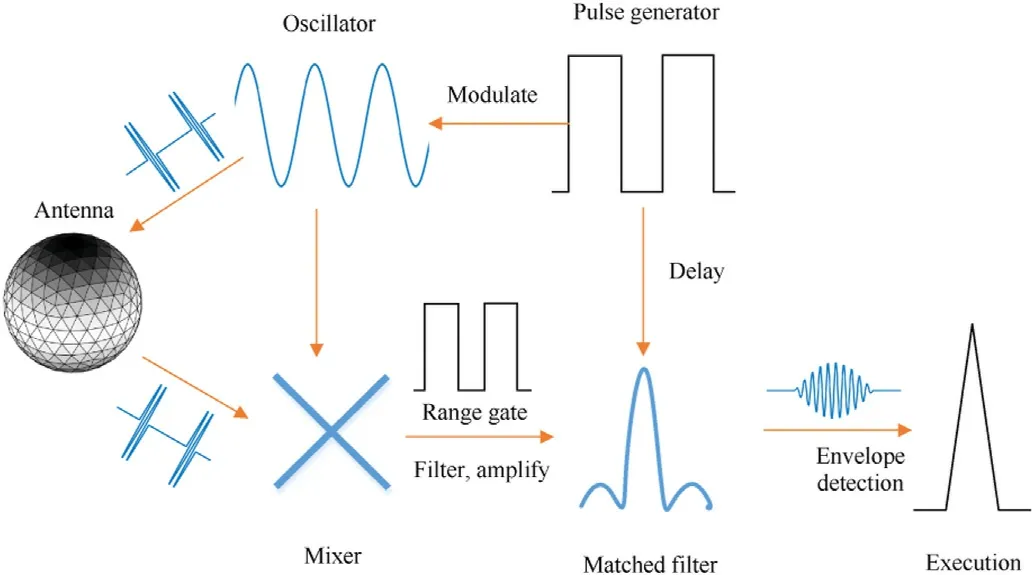
Fig.1.The signal processing block diagram of the PDRF.
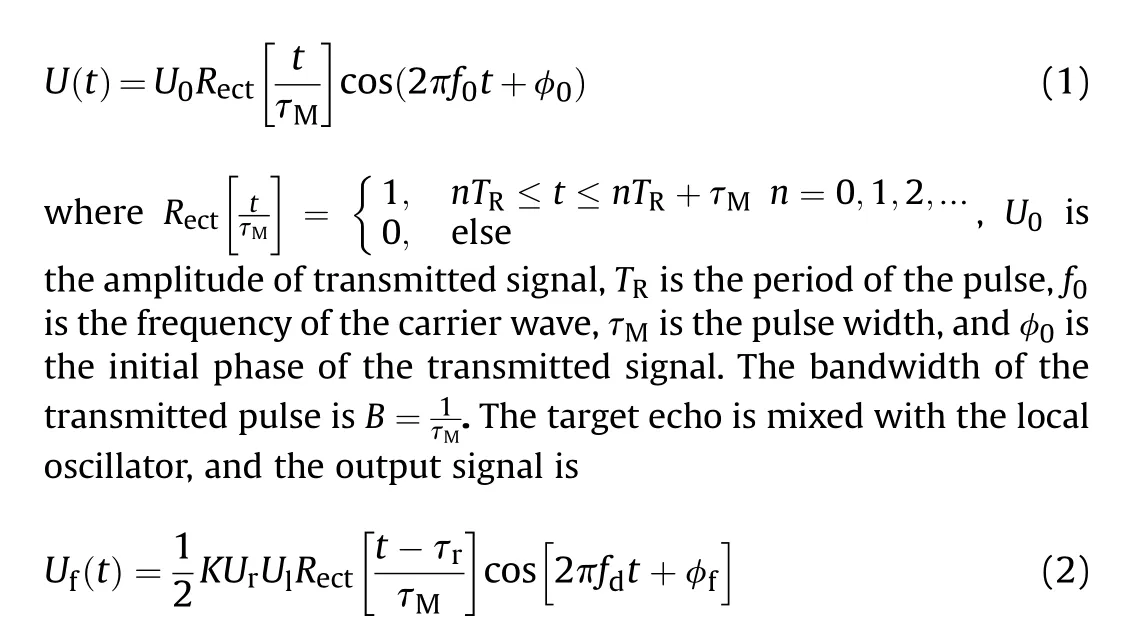
where K is the mixer coef ficient,Uis the amplitude of the target echo,Uis the amplitude of the local carrier wave,τis the delay of the echo target relative to the transmitted signal,fis the Doppler frequency,andφis the initial phase of the output signal.Then,the output of the range gate is
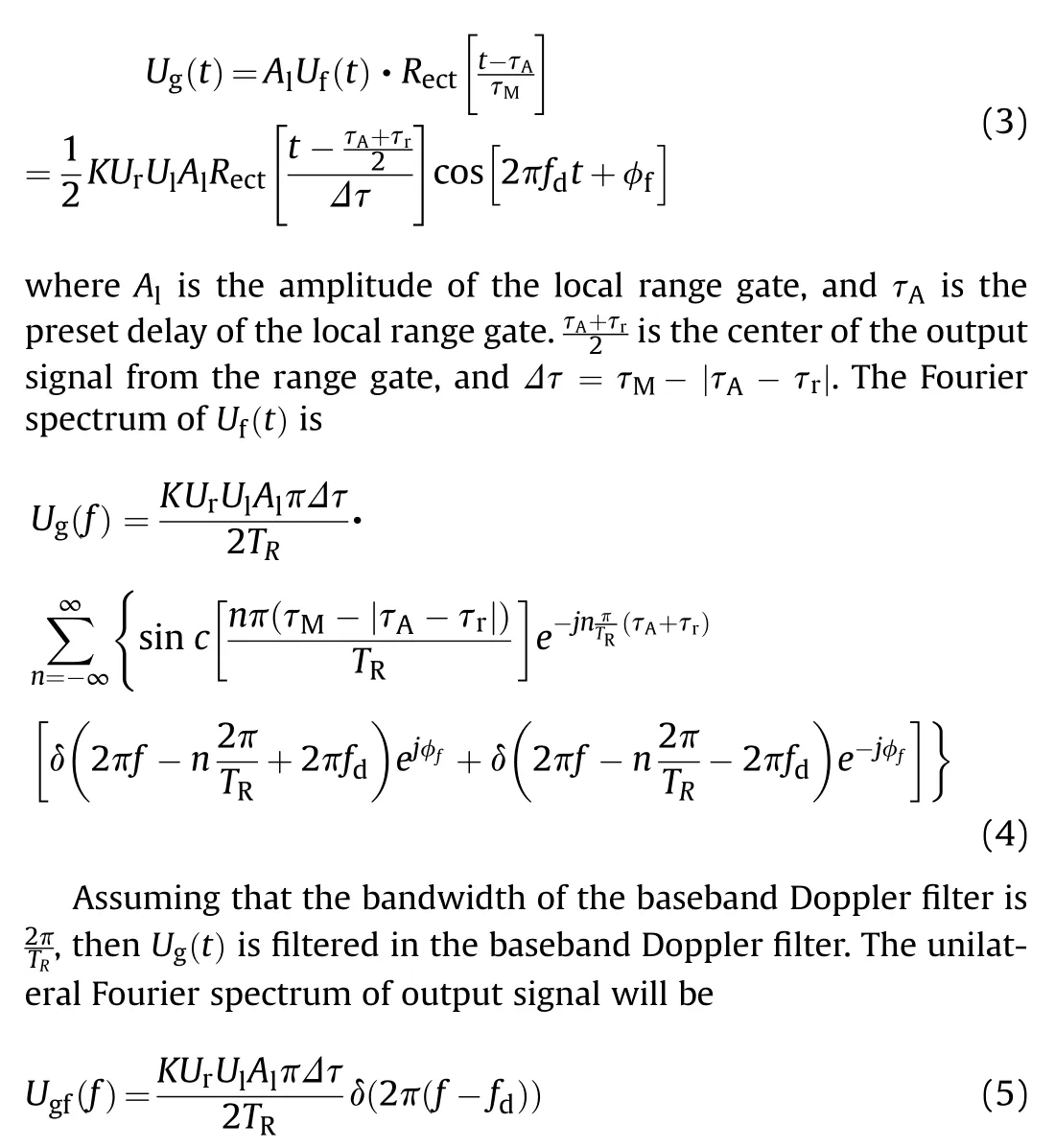
Eq.(5)shows that the amplitude of the output signal from the matched filter is proportional toΔτ,and it has the highest amplitude of the output signal whenΔτ=τ.Therefore,the signal power in time domain mainly converges inτ∈[τ-τ,τ+τ],as shown in Fig.2(a).The signal power in the frequency domain mainly converges in the Doppler frequency,as shown in Fig.2(b).In Fig.2(a),the yellow wave represents the matched filter output of the PDRF,and the green line represents the start signal of PDRF.
2.2.Analysis of noise jamming for the PDRF
Noise jamming mainly depends on the power density to reach the detection threshold of the PDRF,but the output of the range gate of the PDRF is not same as the target echo.Noise jamming includes noise frequency modulate(FM)jamming and noise amplitude modulation(AM)jamming.We take noise AMjamming as an example.
Noise AM jamming can be expressed as[3,4].

where modulation noise U(t)is a generalized stationary random process with a mean of 0,a variance ofσ,and a distribution of[-U,+∞);φis a uniformly distributed random variable;φis independent of U(t);Uand fare the amplitude and frequency of the carrier wave of noise jamming,respectively.Assuming that the jammer already intercepted the transmitted signal of the PDRF and set f=f.The received AM jamming is mixed with the local oscillator,and the output of the range gate is
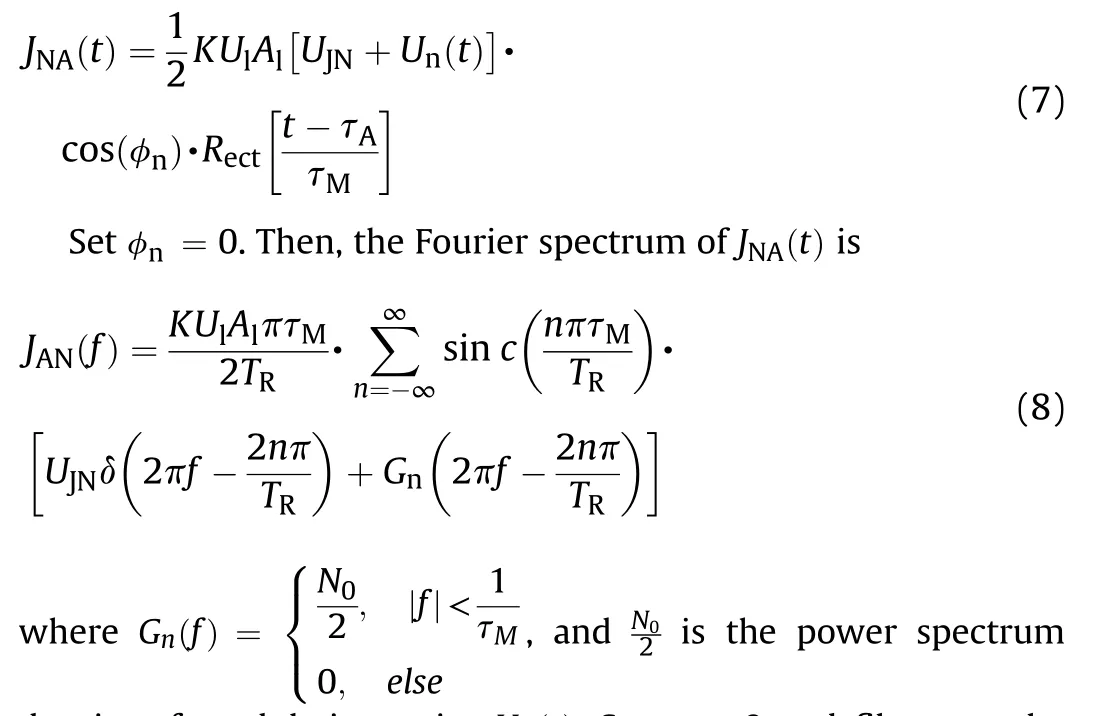
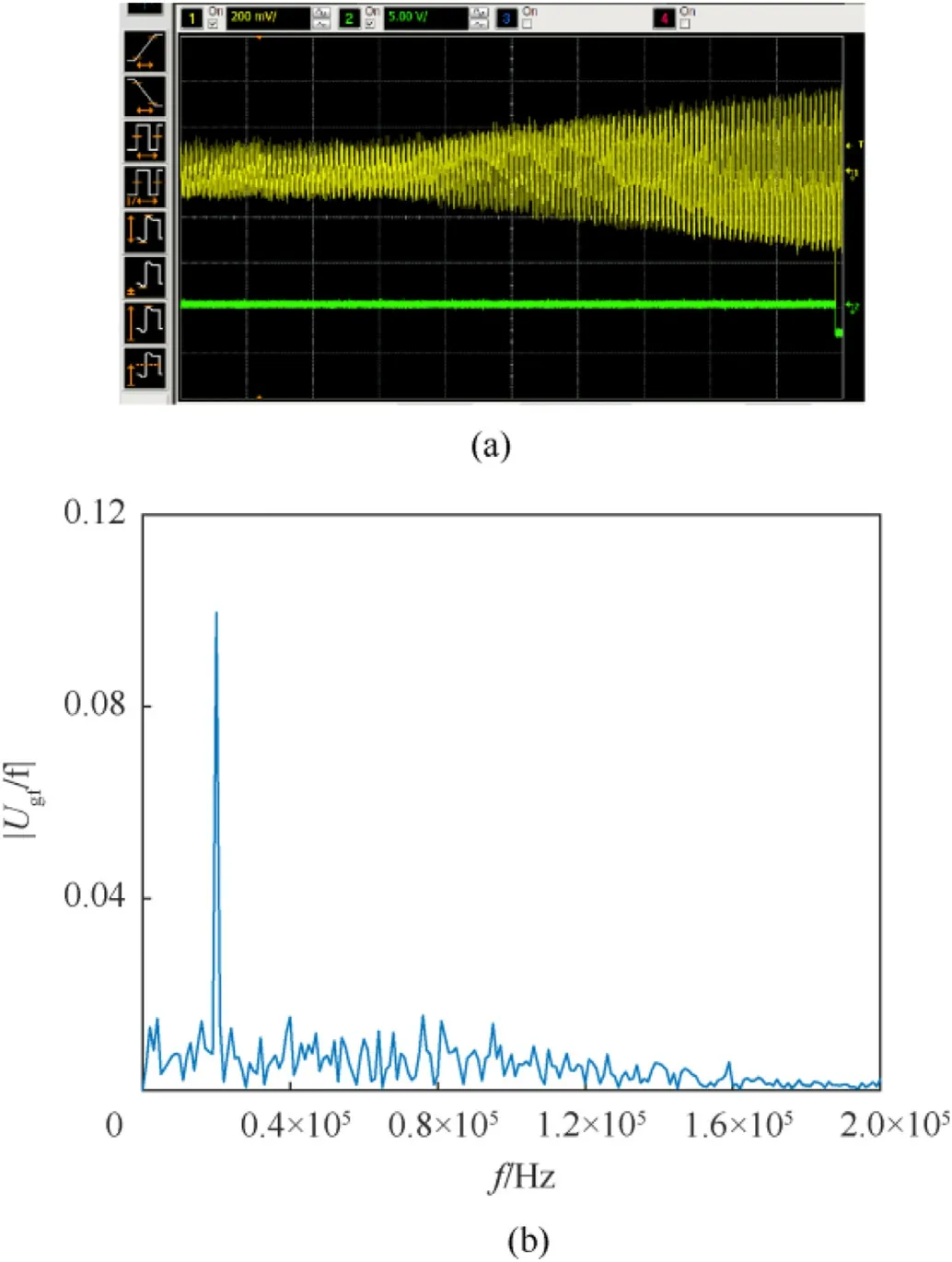
Fig.2.(a)Matched filter output of the PDRF under the action target echo in the time domain,and(b)Fourier spectrum of the matched filter output of the PDRF under the action of target echo.
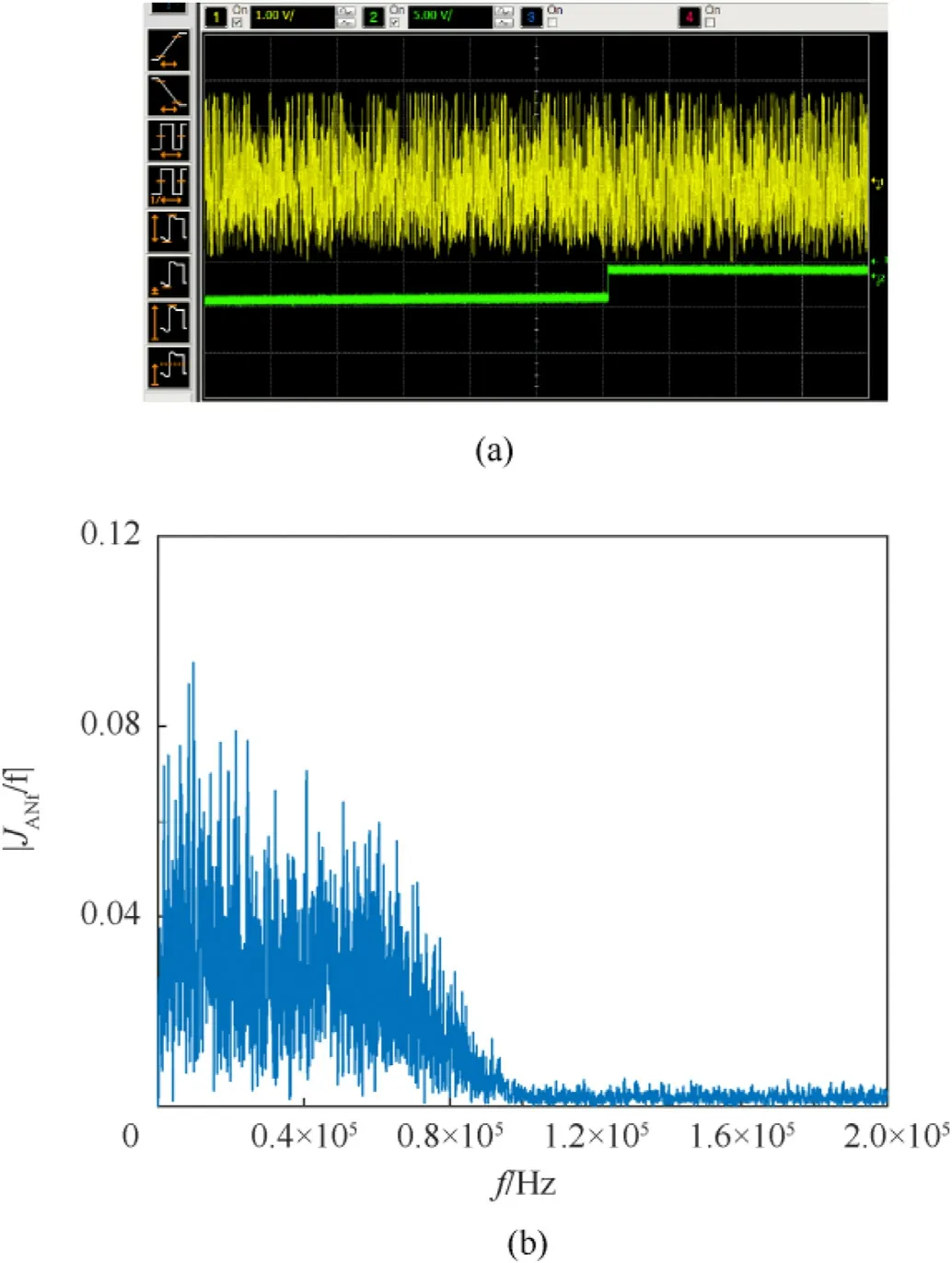
Fig.3.(a)Matched filter output of the PDRF under noise AM jamming in the time domain,and(b)Fourier spectrum of the matched filter output of the PDRF under noise AM jamming.
density of modulation noise U(t).Set n=0 and filter out the current signal.Then,the output of the baseband Doppler filter can be expressed as

Eq.(7)shows that the power of the output signal of the range gate in the time domain is stationary and randomly distributed in the time domain.Eq.(9)shows that the power of the output signal J(ω)of the range gate in the frequency domain is evenly distributed in the bandwidth without an obvious peak.Fig.3(a)is the output of the matched filter under noise AMjamming.Fig.3(b)is the Fourier spectrum of the output signal.Comparing Fig.2 with Fig.3 shows that the output power under noise AM jamming the frequency is more evenly distributed in the bandwidth,which is quite different from target echo.
2.3.Analysis of frequency guided jamming
Frequency guided jamming is a kind of jamming where the jammer measures the frequency of the transmitted signal of the PDRF and generates jamming by modulating on the carrier wave.The modulated signal can be received by the antenna of the PDRF and affect the PDRF.Take sine AM jamming for example.
Sine AM jamming can be expressed as

where Ais the amplitude of the carrier wave,and fis the frequency of the carrier wave.The frequency guided jammer will set the jamming parameter according to the detected transmitted signal of the PDRF;thus,f≈f,whereφis the initial phase of jamming,mis the modulation depth(where 0<m≤1),and fis the frequency of the modulation sine wave.The jamming received by the antenna of the PDRF will be mixed with the local oscillator.Then,the output of the range gate can be expressed as

Eq.(13)and Fig.4(b)show that the output signal power of the matched filter under frequency guided jamming converges in fin the frequency domain,which is similar to the target echo.Therefore,different from noise jamming,it is hard to distinguish target echo and frequency guided jamming using the frequency spectrum only,and the feature in the time domain should also be considered.In Figs.4(a)and Fig.2(a),the amplitude envelope of the matched filter output under target echo gradually increases as the overlap pulse widthΔτincrease,but the amplitude envelope of the matched filter output under frequency guided jamming is stable and irrelative toΔτ.Thus,this feature can be used to classify target echo and frequency guided jamming.
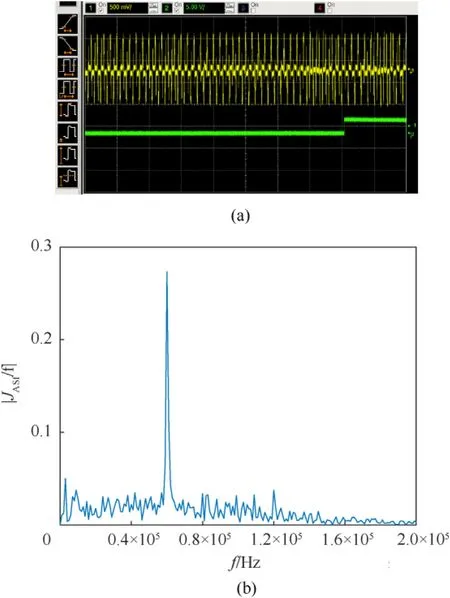
Fig.4.(a)Matched filter output of the PDRF under sine AM jamming in the time domain,and(b)Fourier spectrum of the matched filter output of the PDRF under sine AM jamming.
3.Time-frequency joint feature extraction for the target echo and famming of the PDRF
The concept of information entropy comes from Shannon information theory and is used to measure the uncertainty of information.Information entropy is widely used in optimization and feature extraction for classi fication[23-26].For the set X={x,x,…,x},its information entropy is expressed as

where pis the probability of x.Eq.(14)shows that the more even the distribution of X is,the greater its entropy.Therefore,the point of H(x)is to get the probability density of X.According to the analyses in section 1,the matched filter output of the PDRF in the frequency domain is mainly distributed in the Doppler frequency;however,for jamming,the distribution is more even in the bandwidth of the matched filter.Suppose that W={w,w,…,w}is the frequency distribution of the matched filter output of the PDRF.pand H(W)are de fined as

According to Eq.(15)and Eq.(16),the more even the distribution of the matched filter output in the frequency domain is,the greater the entropy.Thus,the entropy of the matched filter output of the target echo is smaller than that of noise jamming.To verify the effectiveness of the frequency entropy in distinguishing targets and noise jamming,the experiment collected 100 sets of output signals of the PDRF matched filter under target echo and noise jamming(including noise AM jamming and noise FM jamming).The frequency entropy is extracted from the output signal,and the box plots are shown in Fig.5.
In Fig.5,the upper line refers to the max of data,and the lower line refers to the minimum of data.As for the rectangle,the upper line of rectangle refers to upper quartile and the lower line refers to lower quartile,the middle line refers to the median of data.The red point in box plot refers to outliers.The overlap ratio is de fined as

where Nis the number of target echoes that fall in the distribution range of jamming(except outliers),Nis the number of jamming signals that fall in the distribution range of the target echo(except outliers),Nis the number of target echoes,Nis the number of jamming signals.The overlap ratio is shown in Table 1.
The results in Fig.5 and Table 1 show that the frequency entropy of the matched filter output of the PDRF can effectively distinguish target echo and noise jamming.However,the frequency spectrum of the matched filter output under frequency guided jamming is similar to that under target echo.This means that the overlap ratio of the frequency entropy is too high to distinguish frequency guided jamming and target echo.Therefore,additional features need to be provided.In Fig.2(a)and Fig.4(a),the matched filter output amplitude of the target echo increases as the PDRF gets closer to the target,but the matched filter output amplitude of frequency guided jamming remains stable.This difference can be used to distinguish between frequency guided jamming and target echo.The peak-topeak ratio of the amplitude is de fined as


Fig.5.Box plots of the frequency entropy of the matched filter output under target echo and noise jamming.
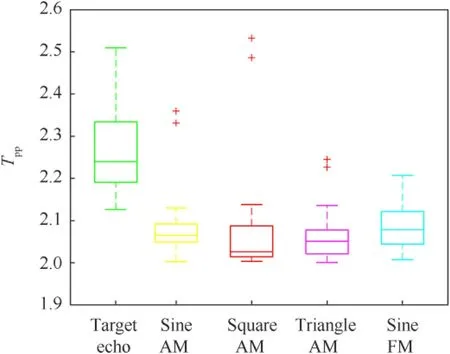
Fig.6.Box plots of the peak-to-peak ratios of the matched filter output under target echo and frequency guided jamming.

Table 1 Overlap ratio of target echo and noise am jamming.
where T,Tand Tare the three biggest peaks of the signal,and T>T>T.The experiment collect 50 sets of data under the action of 4 kinds of frequency guided jamming,including sine AM jamming,square AM jamming,triangle AM jamming,and sine FM jamming.Each set includes a 0.2 ms matched filter output of the PDRF.The peak-to-peak ratio box plot and overlap ratios of the target echo and 4 kinds of jamming are shown in Fig.6 and Table 2,respectively.
Fig.6 and Table 2 show that the peak-to-peak ratio distributions of the target echo and frequency guided jamming are signi ficantly different from each other.Therefore,the peak-to-peak ratio can effectively recognize target echo and frequency guided jamming.

Table 2 Overlap ratios of the target echo and noise am jamming.
The feature space of the baseband output of the PDRF is obtained by combining the two features in frequency domain and time domain,as shown in Fig.7.
In Fig.7,there is a clear difference between the feature spaces of target echo and jamming.Therefore,the validity of the feature space constructed using the frequency domain entropy and time domain peak-to-peak ratio is veri fied.Moreover,the classi fier should be constructed to further improve the recognition accuracy.
4.Construction and update of adaptive NBC based on the minimum risk criterion
4.1.Construction of NBC with minimum risk for the recognition of target echo and jamming
The NBC is a classi fication algorithm based on Bayes’theorem.Its principle and construction method are relatively simple compared to pattern recognition algorithms such as support vector machines and neural networks,which meets the high real-time requirement of the PDRF[27-30].The core idea of the naive Bayes classi fication algorithm based on the minimum risk criterion is to calculate the posterior probability and conditional risk of each sample for each class under the condition that the sample characteristics are independent of each other,and then the class with the least conditional risk is chosen as the final class.Assuming that y is the data to be classi fied,the posterior probability for each class is

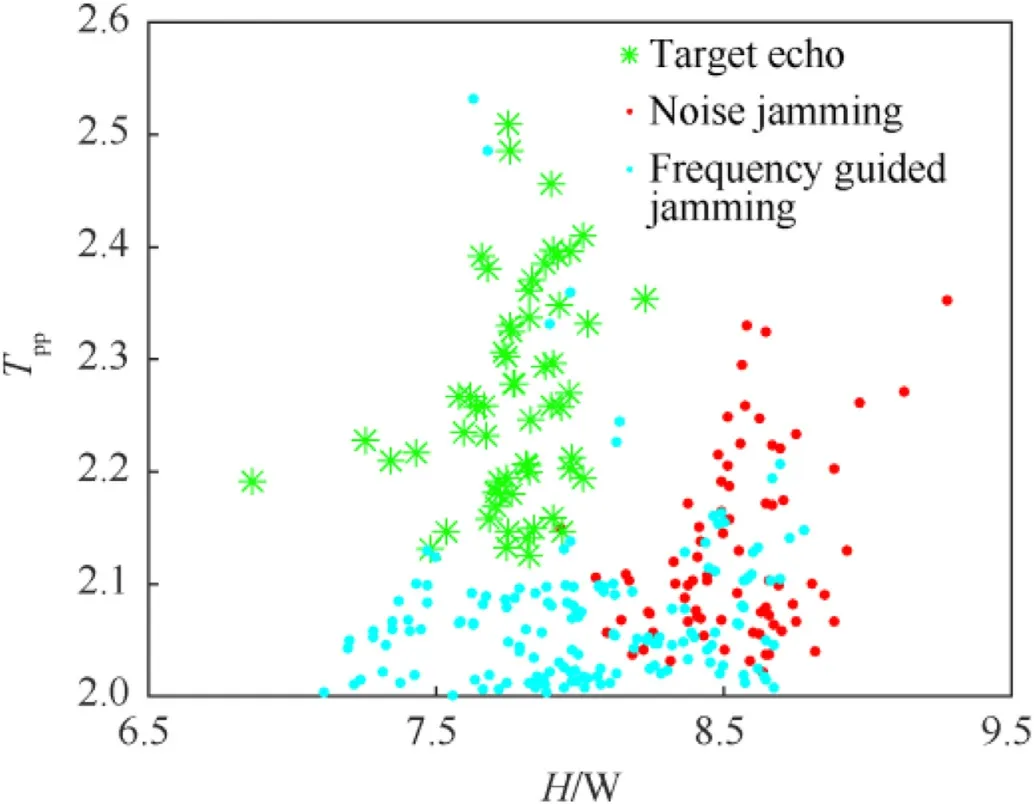
Fig.7.Time-frequency joint feature distribution of target echo and jamming.
where y=[y,y,…,y];y,k=1,...,n is the k th characteristic value of y;p(y|c)is the conditional probability of y to c;p(c)is the posterior probability of c;and m is the total number of classes.p(y|c)can be expressed as

As shown in Eq.(20),the key to the calculation of p(y|c)is p(y|c).Generally,it is assumed that the sample satis fied the Gaussian distribution while calculating the conditional probabilities.Then,

whereμandσare the mean and standard deviation of the k th characteristic value of the sample in class c,respectively.Set y=H(W)and y=T.crefers to target echo,and crefers to jamming.The experiment collected 100 sets of matched filter outputs of the PDRF under target echo and 300 sets under jamming.The time-frequency joint features of the collected data are extracted,and then{μ,μ,μ,μ}and{σ,σ,σ,σ}are calculated.The conditional probability density distribution of each attribute of the samples under the assumption of a Gaussian distribution is obtained.The results are shown in Fig.8.
In Fig.8,the distribution of each attribute of the target echo is obviously different from that of jamming.By comparing Fig.8 with Figs.5 and 6,it can be found that the probability density distribution is relatively consistent with the real distribution,which veri fies the effectiveness and correctness of the Gaussian distribution assumption of the samples.
Finally,the conditional probabilities p(y|c),p(y|c)and the posterior probabilities p(c|y),p(c|y)can be obtained using Eq.(19)and Eq.(20),respectively.Thus,the class of y is

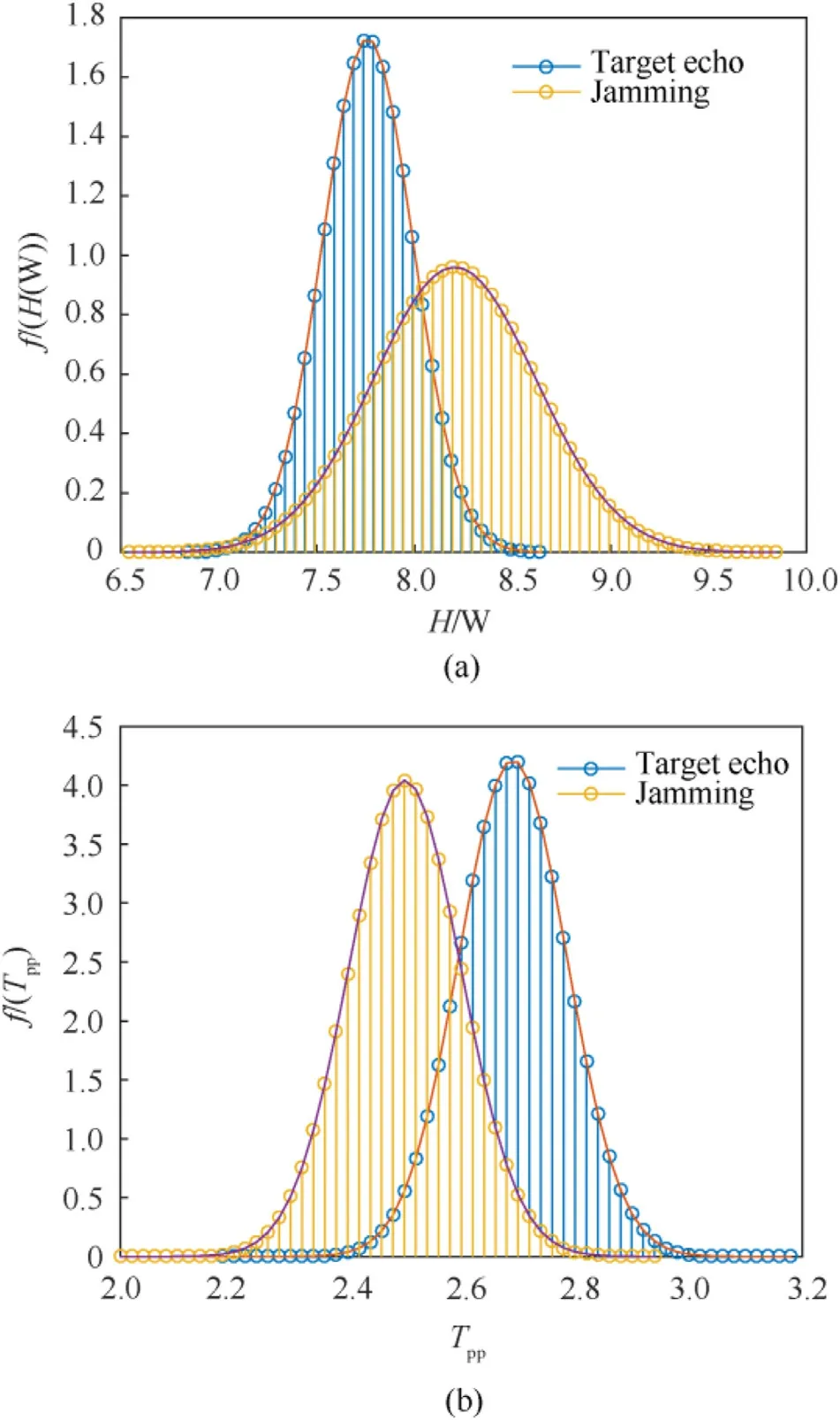
Fig.8.(a)Probability density distribution of the frequency entropy of target echo and jamming,and(b)the probability density distribution of the peak-to-peak ratio of target echo and jamming.



As for an early explosion,the PDRF can only act once.Once the PDRF mistakes the jamming as the target,it will cause the PDRF to explode early.Thus,the risk of an early explosion is
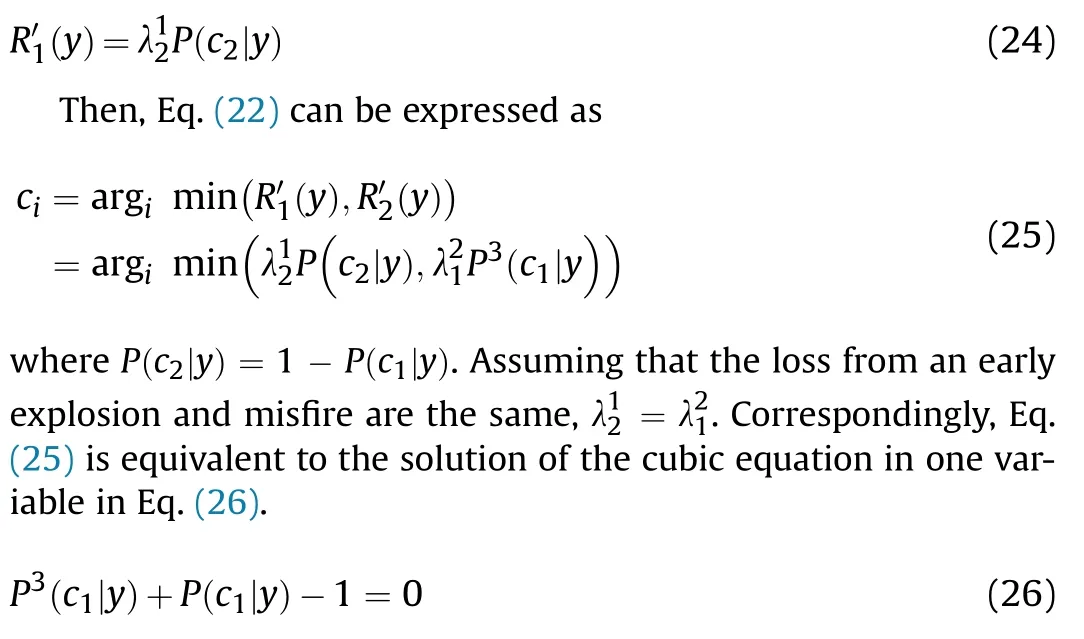
The calculation complexity of finding the solution of the cubic equation will in fluence the real-time performance of the PDRF.Thus,we use an approximate algorithm instead,and the speci fic steps are as follows(accurate to the percentile).
(1)Calculate the value of the equation starting from 0.5 to determine the decile value.
(2)Use the same method to determine the percentile.
Then,the total number of operations does not exceed 10 times,the error does not exceed five thousandths,and the complexity is no more than O(10).The solution of Eq.(26)is P(c|y)=0.68.This means that if P(c|y)<0.68,then y will be recognized as jamming;otherwise,y will be recognized as the target.The classi fication results obtained via the above method can minimize the decision risk.To verify the effect of the naive Bayesian classi fication algorithm based on the minimum risk criterion,the classi fication accuracy is de fined as

where Nis the number of samples that are wrongly recognized as jamming but are actually target echo,and Nis the number of samples that are wrongly recognized as target echo but are actually jamming.The k-fold cross-validation method is used,where k=10.The method divides the 100 sets of target data and 300 sets of jamming data measured in the experiment into 10 parts.One part is taken each time(including 10 sets of target data and 30 sets of jamming data)as the data to be tested,and the other 9 parts are used as training data.The classi fication accuracy is shown in Table 3.
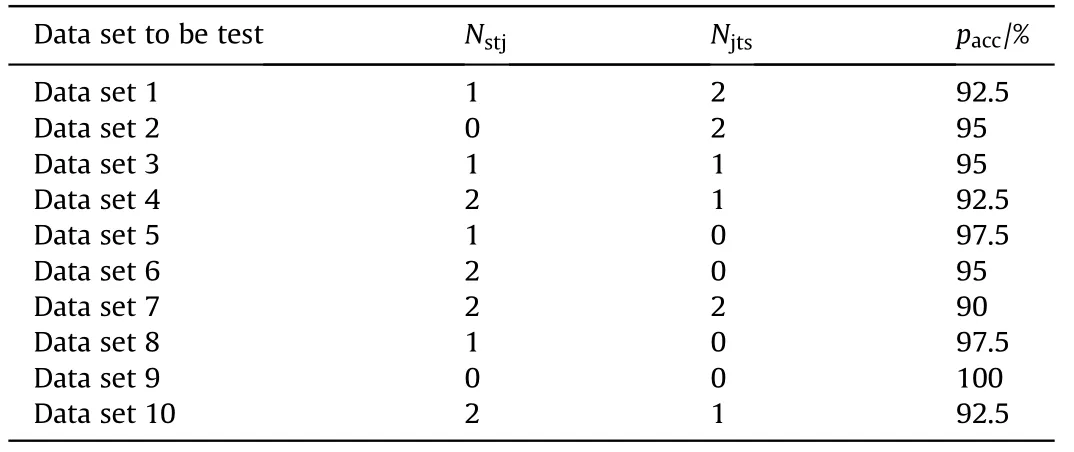
Table 3 Classi fication accuracy of 10 kinds of data sets.
Table 3 shows that the naive Bayesian classi fication algorithm based on the minimum risk decision can effectively identify PDRF targets and interference signals,and its recognition rate is higher than 90%.
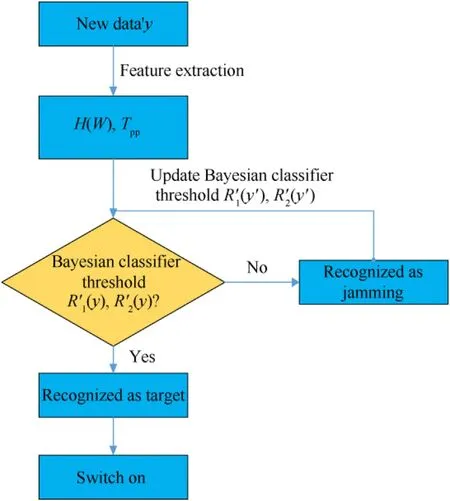
Fig.9.Adaptive updating process of the Bayesian classi fier threshold.
4.2.Adaptive threshold of NBC based on online learning
Due to the difference between the real working environment of the PDRF and the laboratory,the actual background noise may further deteriorate the input SNR of the received signal of the PDRF receiver.The time domain and frequency domain of the output signal of the PDRF matched filter will be more complicated,resulting in changes in the signal frequency entropy and peak-topeak ratio.This will reduce the recognition effect of the pretrained naive Bayesian classi fication model.Therefore,the classifier threshold needs to be adjusted in real time to maintain a high recognition rate.The process is shown in Fig.9.
Assuming that the PDRF extracted feature of the data is sampled every 0.2 ms,the extracted feature of the data to be tested is y=[y,y].The speci fic steps of the adaptive update are as follows.
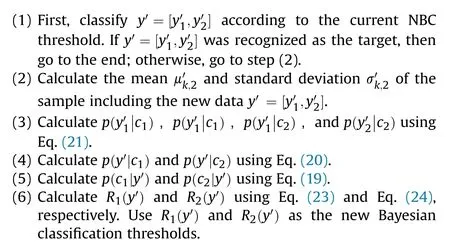
To test the effect of updating the classi fication model under different SNRs,Gaussian white noise is added to the target and jamming samples measured in the experiment.Ten sets of data with an SNR from-10 dB to-1 dB and JSR from-4dB to 5 dB are generated as the signals to be measured.Each set contains 100 target samples and 300 jamming samples.Meanwhile,considering the low duty ratio and high ranging resolution of PDRF,the pulse width in the simulation is 20 ns,and the pulse repetition period is 4μs according to the realistic application[4].The parameter settings are as shown in Table 4.
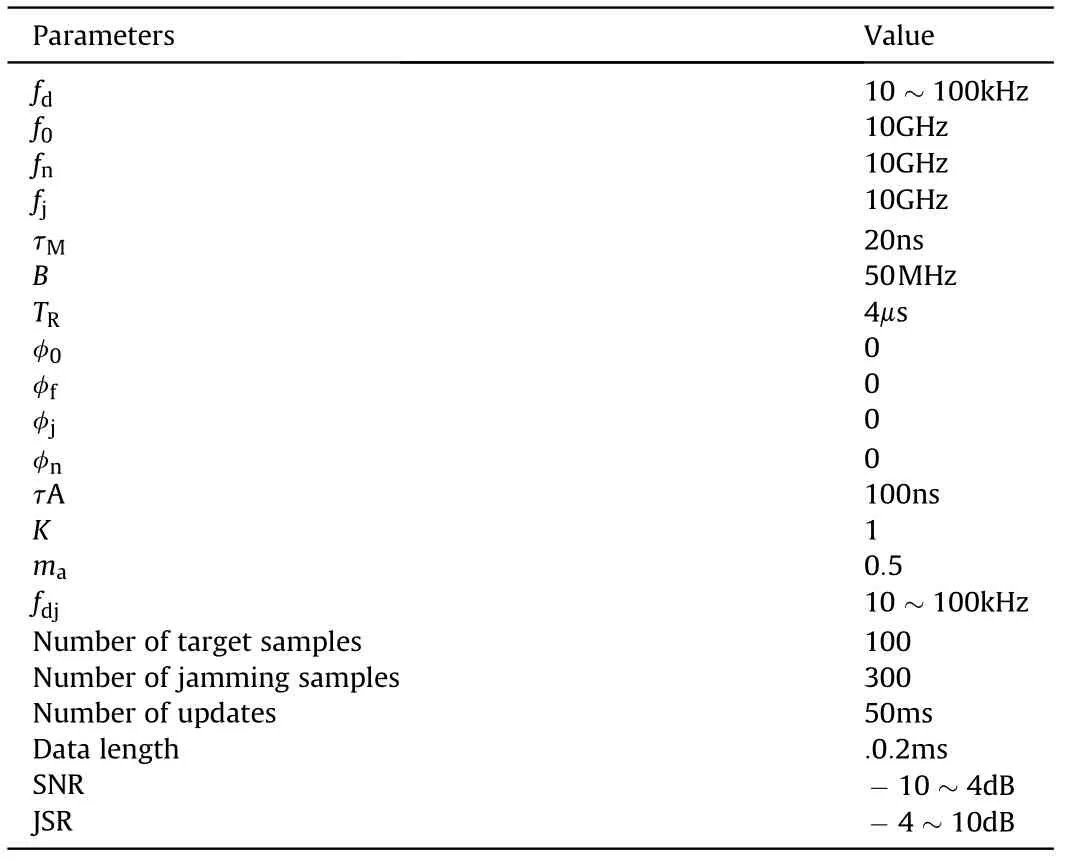
Table 4 Parameter settings.
Then,we compare the recognition accuracy of the Bayesian classi fier threshold without the update with the adaptively updated Bayesian classi fier for each set.The results are shown in Fig.10.
Fig.10 shows that the recognition accuracy of the Bayesian classi fier model without the update drops rapidly as the SNR decreases while the adaptively updated Bayesian classi fication model maintains a high recognition rate even when the SNR decreases.The reason is that the decrease of the SNR changes the features of the matched filter output in the frequency domain and time domain.Correspondingly,the pre-trained model no longer adapts to the signal features due to the deteriorating SNR,resulting in the recognition accuracy declining rapidly.However,the Bayesian classi fication model with the adaptive update can learn the changes in the signal characteristics and adaptively adjust the classi fier threshold according to the new input data so that the adaptive classi fier can maintain a high recognition rate when the SNR changes.Furthermore,the samples generated using different SNRs are used to test the recognition accuracy of the adaptive NBC with different update times.The results are shown in Fig.11.
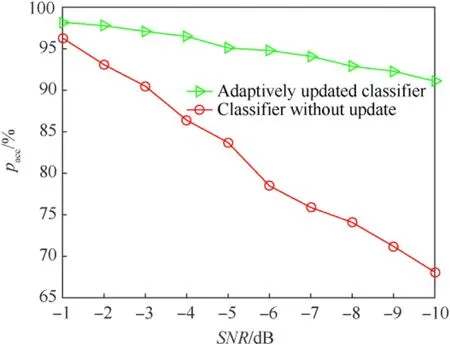
Fig.10.Recognition accuracy of the updated classi fier and the classi fier without the update.
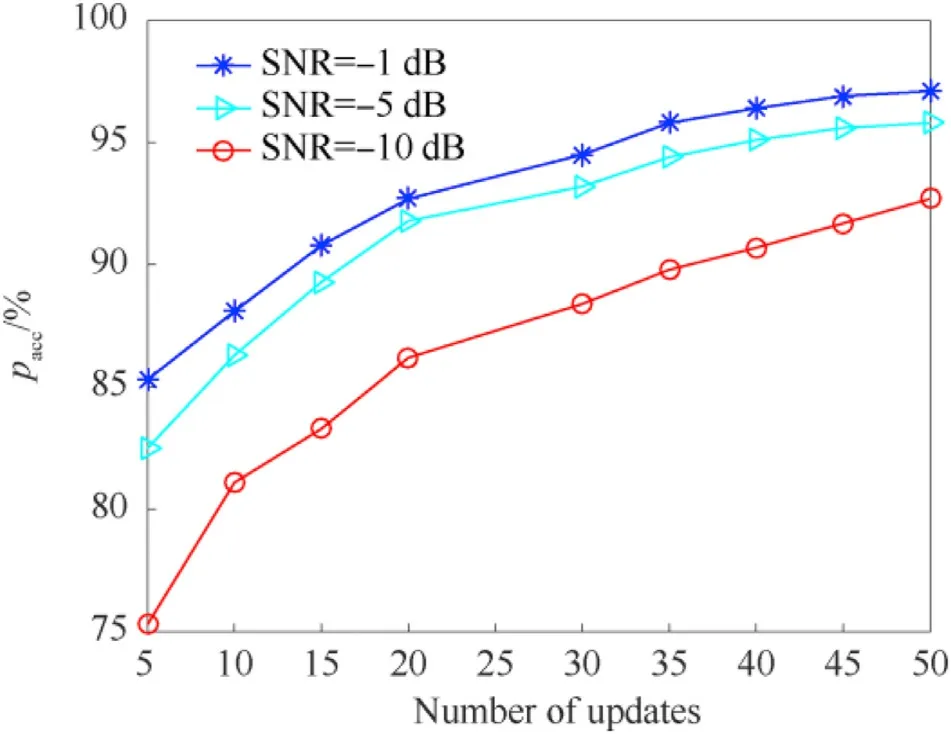
Fig.11.Recognition accuracy of the adaptive Bayesian classi fier with different numbers of updates at SNRs of-10 dB,-5 dB,and-1 dB,respectively.
In Fig.11,the recognition accuracy of the updated Bayesian classi fier model for the targets and jamming of the PDRF gradually increases as the number of updates increases.The figure shows that the adaptive Bayesian classi fier can learn the changes of joint features in the time and frequency domains according to the input data.As the number of updates increases,the addition of increasingly more data makes the Bayesian classi fier gradually adapt to the signal features under the current SNR,resulting in a more accurate classi fier threshold and higher recognition accuracy.
Moreover,to further evaluate the target and jamming recognition performance of the ONBCMR,the experiment compares the ONBCMR with empirical mode decomposition in Ref.[19](method 1),the Unintentional Modulation On Pulse(OMUP)method in Ref.[18](method 2),and the quadratic time-frequency method in Ref.[22](method 3).The results are shown in Fig.12.
In Fig.12,the four methods all achieve good recognition accuracy at high SNRs and low JSRs.When the JSR are less than-2dB,the recognition accuracy of ONCBMR are slightly lower than method 1.However,when the SNR continues to decrease,Fig.12(a)shows that only the ONBCMR maintain high recognition accuracy while the recognition accuracies of the other methods decrease rapidly.Fig.12(b)shows that the ONBCMR can maintain high recognition accuracy(more than 85%)at 5 dB JSR,but other are less than 80%.The results verify the effectiveness of the time-frequency joint feature,which can provide signi ficant difference for the recognition of target and jamming.It also veri fies the advantages of the ONBCMR in an unstable SNR environment due to the adaptive online update.
In addition,Fig.12(b)also shows when the JSR is worse the 5 dB,the recognition accuracy of the four methods decrease rapidly.The recognition accuracy of ONBCMR drops to 80.6%at 10 dB JSR,although still performs better than other methods,will result in some misrecognized samples.Thus there should be enough samples be trained and more numbers of update for a better recognition accuracy of jamming and target echo.
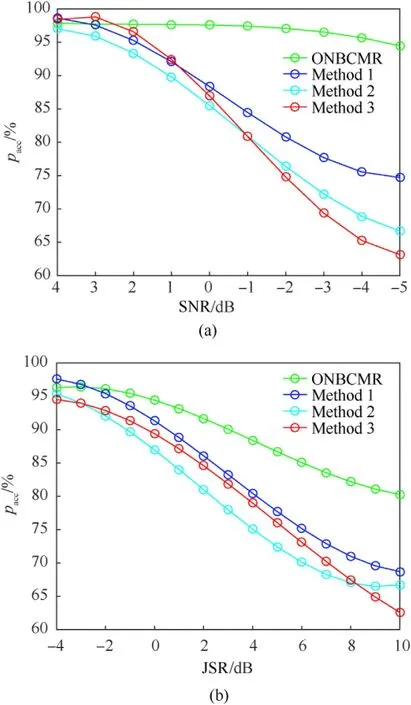
Fig.12.(a)Recognition accuracy of the ONBCMR and other methods at different SNRs,and(b)recognition accuracy of the ONBCMR and other methods at different JSRs.
5.Applicability analysis


The adaptive update of the naive Bayesian classi fier mainly contains the calculations of the mean and standard deviation of the samples,and the new classi fier threshold based on the minimum risk after the new sample is added.Assuming that M is the initial sample size,then the calculations of the mean and standard deviation requires 3M-2 addition and 2M+1 multiplication operations,and the complexity is O(5M-1).The classi fier threshold based on the minimum risk can be obtained according to Eq.(19)-Eq.(26),and the complexity is no more than O(53).Thus,the complexity of the adaptively update of the classi fier is

Supposing that the PDRF collected 0.3 ms of data for feature extraction and classi fication,the sampling rate is 10sample/s,that is,N=300.If the clock of the field programmable gate array(FPGA)is 100 MHz,it will take approximately 0.47 ms to complete the calculation of the frequency entropy.If we set the of fline training sample size M=400,the update of naive of Bayesian classi fier takes approximately 0.02 ms.Therefore,the additional time consumption for a classi fication process(including feature extraction and the classi fier update)is approximately 0.49 ms,which meets the real-time requirement of the PDRF.Moreover,as shown in Fig.11,the NBC achieves high recognition accuracy after updating 50 times.Assuming that the PDRF updates the classi fier every 1 ms,it only takes 50 ms to update 50 times.Therefore,the time consumption performance meets the real-time requirement of the PDRF.
The ONCBMR are mainly used for anti-noise jamming and antifrequency guided jamming.As for the deceptive jamming[31-33],when the deceptive could deceive the matched filter,the matched filter output would be similar to target echo.Correspondingly,the performance of ONCBMR would decrease in the recognition of deceptive jamming and target echo.
Moreover,the proposed ONCBMR method is a general method for radar target and jamming recognition.The time-frequency joint features are analyzed and extracted from the output signal of matched filter.Even the signal processing processes are different for many kinds of radar signal with different intra-pulse modulation,but the signal features of target echo and jamming from matched filter of them are similar.Therefore,the method can be generally applied to PDRF regardless the modulation type of the radar signal.
6.Conclusion
Aiming at the problems of the insuf ficient target recognition accuracy and anti-jamming ability of the PDRF,this paper proposes an adaptive target and jamming recognition method based on an online updated naive Bayes classi fier with minimal risk.By analyzing the time domain and frequency domain characteristics of the output signal of the PDRF matched filter under the target and jamming,the time-frequency joint feature space of the target and the jamming is constructed.Then,a naive Bayes classi fication model based on the minimum risk using the extracted signal features is established.The threshold of the classi fier is adaptively updated online according to the input signal received by the PDRF during the working process.The research results show that the adaptively updated naive Bayes classi fier with the minimum risk still maintains a high recognition accuracy when the SNR and JSR deteriorates.Finally,the real-time performance of the method is analyzed,and the results verify the feasibility of applying the ONCBMR to the target recognition and anti-jamming of the PDRF.
This work is supported by the National Natural Science Foundation of China(Grant No.61973037 and No.61673066).
There is no con flict of interest.
杂志排行
Defence Technology的其它文章
- High explosive unexploded ordnance neutralization-Tallboy air bomb case study
- Dynamics and rebound behavior analysis of flexible tethered satellite system in deployment and station-keeping phases
- Finite element analysis of functionally graded sandwich plates with porosity via a new hyperbolic shear deformation theory
- Investigation on the penetration of jacketed rods with striking velocities of 0.9-3.3 km/s into semi-in finite targets
- The effect of strain rate on compressive behavior and failure mechanism of CMDB propellant
- In fluence of metal/composite interface on the damage behavior and energy absorption mechanisms of FMLs against projectile impact
